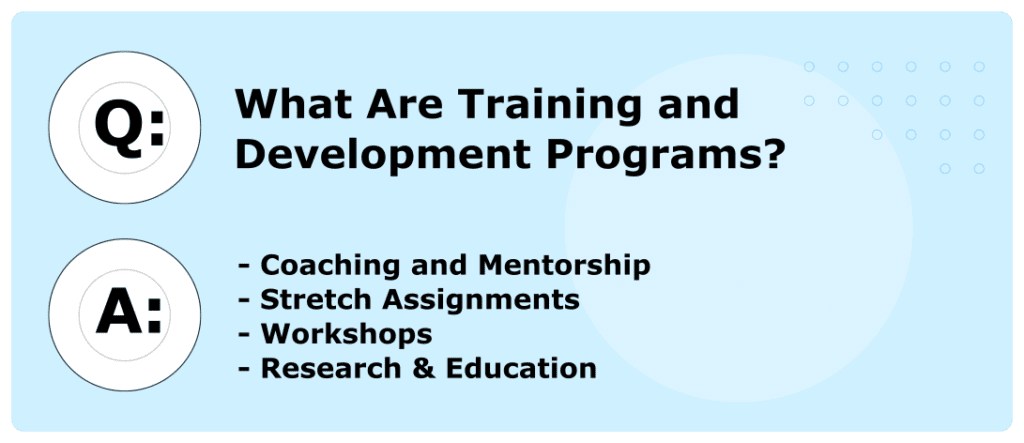Training and Development Programs For Employee Success

The good news is that many organizations are naturally inclined towards conducting training and development programs—often without even realizing it. Employees, by instinct, seek ways to hone their skills, advance in the organization, and support their peers. Outsourced HR providers and internal employee development teams have the essential task of channeling these instincts in directions that align with your business’s growth objectives.
In today’s fast-paced and competitive business environment, ensuring that these natural inclinations are directed effectively becomes even more crucial. As businesses grapple with the challenges posed by rapid technological changes and evolving market demands, it’s vital to ensure their workforce remains adept, adaptive, and forward-thinking.
The training and development process begins with defining characteristics you want to see grow in your organization. That might be a commitment to developing more leadership, creating a more dynamic environment, or a culture of self-improvement. From that vision, it’s about introducing necessary elements through training and development programs.
What Are Training and Development Programs?

Let’s define some training and development strategies in HRM, or human resource management. These are programs you can put into place systematically with the help of your human resources team, or you can simply promote these tools from the top down to encourage organic development.
Coaching and Mentorship
It’s natural for veteran employees to work alongside newer or less-experienced staff to instruct on processes, day-to-day training, and other onboarding measures. Your aim is to make these coaching and mentorship intentional and structured, and to accomplish improved performance, skill sets, and employee knowledge.
Stretch Assignments
Promote development with projects like stretch assignments, which are designed to put employees in situations, real or imagined, that go beyond their basic job responsibilities and ask them to complete a task that often requires additional organization and leadership. Ensure employees are aware of the stretch assignment and that they know the purpose of assigning them the work is to enable their development.
Workshops
How often are your teams meeting together to discuss current, upcoming, or previous projects to evaluate efficiencies, communication, strategy, or process? Often we get pushed onto the next project or task and never stop for review. Workshops help teams and individuals reflect on their involvement with a project (upcoming or previous) so they can develop improvement strategies.
Research & Education
How often do employees receive time to dedicate towards research and continuing education in their field? More often than not, we’re too devoted to the task and production at hand to take employees away from a project. But this intentionality is key to promote employee development and create a culture that places value on learning.
What Are Examples of Training and Development?
So what might be some examples of training and development programs for employees from the list of programs above?
- Instead of conducting annual reviews, create a stretch assignment and have employees complete annual presentations that put them in front of leadership to review departmental goals, projects, and future aims.
- As a way to cross-train employees, build out a program of mentorship and coaching across departments, pairing newer employees with veterans and giving them time each week to review processes, discuss previous projects, and more.
- Take time during your next project kick-off meeting introduce a workshop element: encourage team members to define three or four project process goals to collectively work towards. At the end of the project, conduct a group assessment to reflect.
Why Invest in Employee Training and Development?
It’s more than just an innate desire to grow; it’s about tangible results. According to recent research, companies that actively invest in employee training see a 24% higher profit margin than those that don’t. Moreover, organizations offering comprehensive training programs boast a staggering 218% higher income per employee. These numbers not only validate the inherent employee drive for improvement but also highlight the concrete benefits of well-structured training and development initiatives. In the intricate dance of business growth, training is the rhythm that keeps the organization moving seamlessly and efficiently.
How Can We Improve Our Training and Development?
One of the most important things you can begin today to improve training and development within your organization is to start the process of creating an employee development plan with each of your employees. A tool like an employee development plan bridges the gap between the organization’s goals and the individual’s goals.
Employee development plans provide the opportunity for employees and leadership to have conversations about what courses of action, trainings, and development programs might be beneficial for the employee’s growth. During these talks, identify skills gaps, areas of interest, leadership opportunities, and training opportunities.
Develop Your Employee Training Program With Milestone
Getting an outside perspective is important—both in terms of strategy and accountability. At Milestone, we know how to develop a training plan for employees, and we’re flexible in helping you develop programs within your organization. As outsourced HR strategists, we first help you define your goals and then work together to take actions that are measurable and effective.
Whether that means working with your current internal human resources professional for additional support, or if you want us to conduct the entire process ourselves, our goal is to make credible improvements that will continue to benefit new and current employees and the overall health of your business.
Want to learn more? Contact Milestone Business Solutions today and start a conversation that could lead to impactful change in your business.
Related Content

Is Indiana A Right-To-Work State?
Indiana officially became a right-to-work state in 2012, joining a growing number of states that have adopted similar legislation. Learn more ...

HR Requirements For Small Businesses In Indiana
For small businesses in Indiana, the necessity of having a dedicated HR department is often a topic of debate. Explore ...

HR Requirements For Small Businesses In Indiana
For small businesses in Indiana, the necessity of having a dedicated HR department is often a topic of debate. Explore ...
Stay in the know